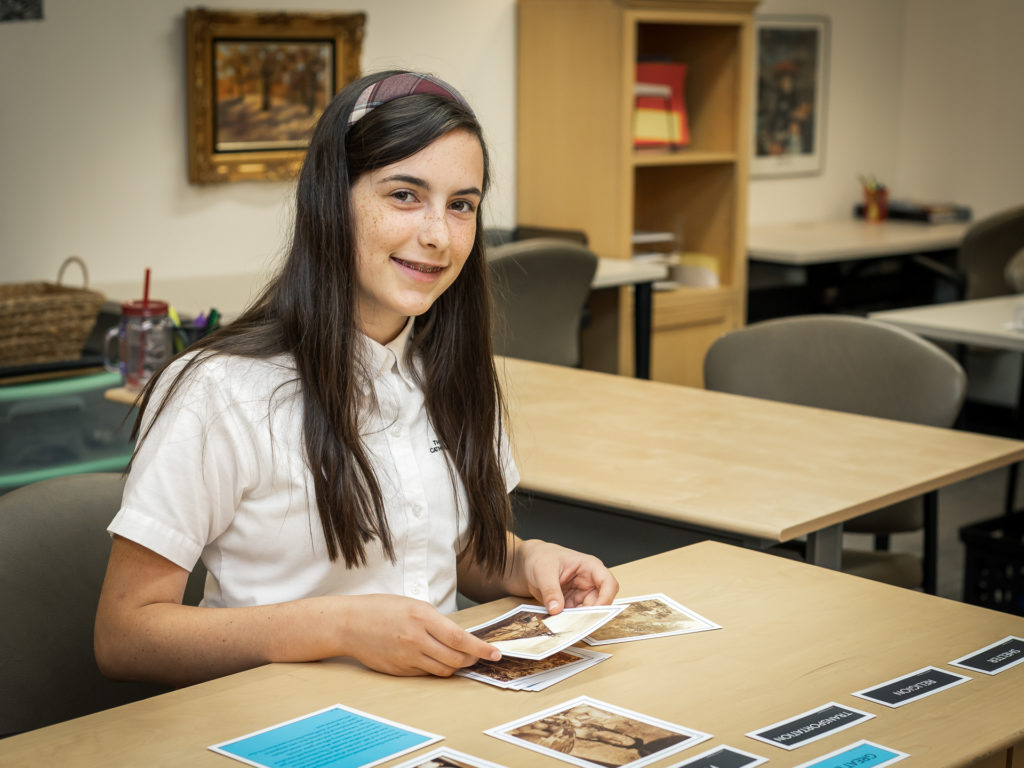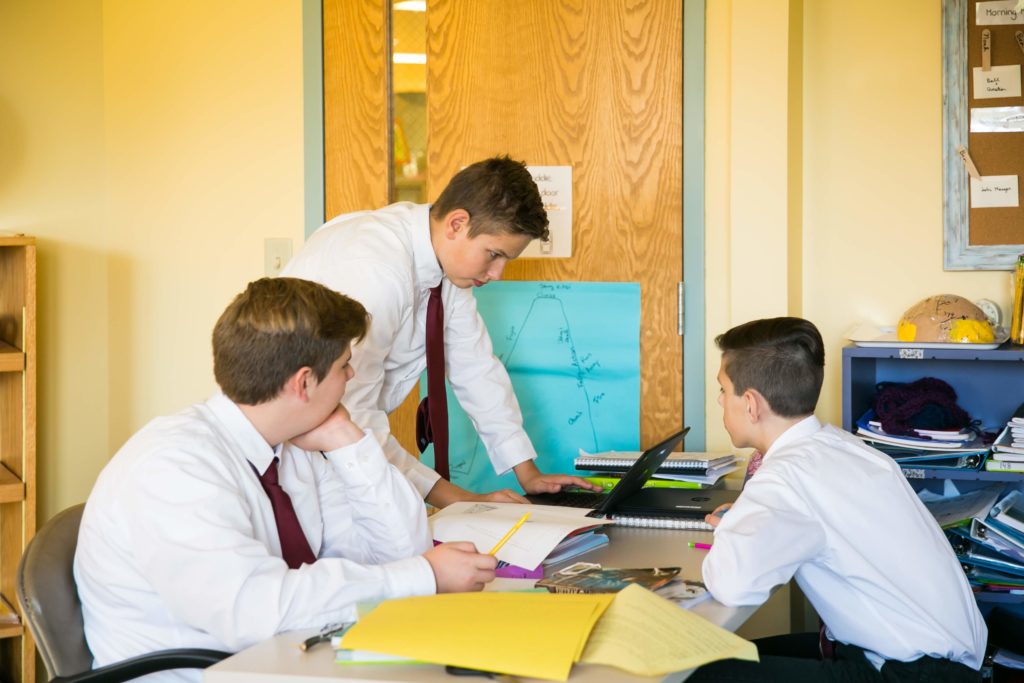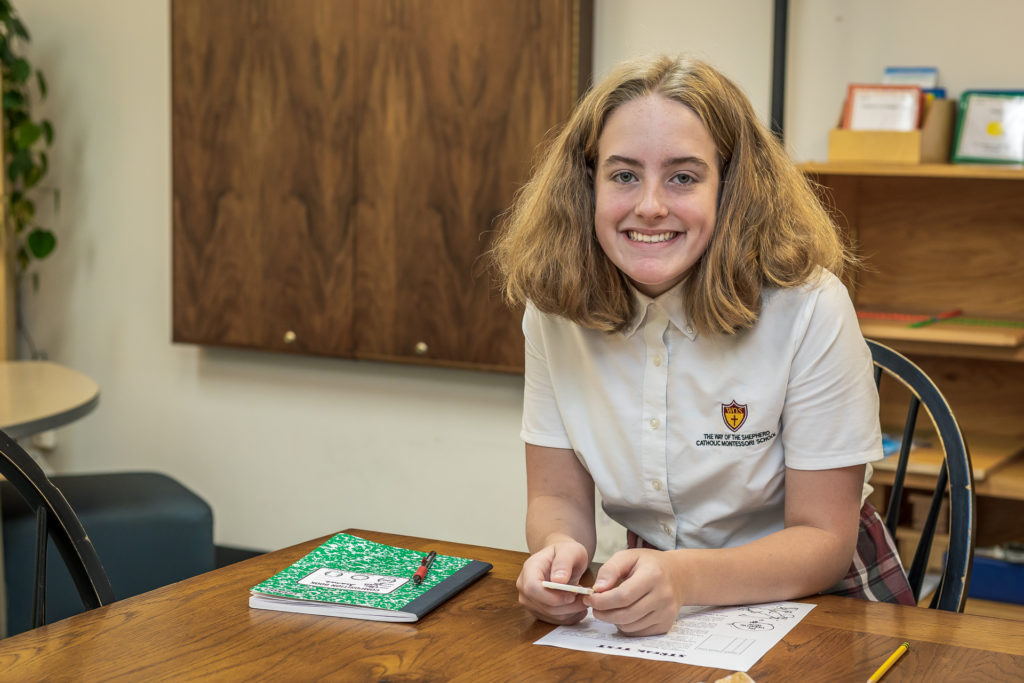The Adolescent Program integrates rigorous academic studies with purposeful work, preparing teenagers to become contributing adult citizens who are self-confident and possess skills needed to thrive in society.
The program works with the developmental essence of adolescents to help them live full, vital lives. In addition, the program offers thoughtful environments and experienced teachers attuned to these needs, safeguarding the young learners’ well being while preparing them for adulthood. It is characterized by a student-centered approach that enables students to manage time, exercise choice, organize themselves, and practice self-regulation within a group context. This development of independent self-management is crucial to succeeding in higher education and adulthood.
Montessori Secondary programs are rooted in hands-on, experiential learning. Your adolescent may have an opportunity to start a business, complete with developing a business plan and securing funding, or work as an apprentice to an expert in a field she loves.
The Montessori Secondary program also includes advanced courses in language arts, mathematics, sciences, and social studies that are academically challenging. Ultimately, the programs support each student in finding a place in the community and in becoming a respectful, responsible, and ethical contributor to society.
Isn’t this exactly what you want for your child’s teenage years?
Adolescent environments are based on the following key principles:

Personal Dignity
They treat each other with respect and are comfortable with the knowledge that each person has different strengths and challenges. Students are expected to bring a high level of independence and self direction, a comfort with collaborative work, and a love of learning for learning’s sake. Montessori adolescents continue to learn without letter grades or gold stars. Conversations with the teachers and written remarks on papers compliment the most important barometer of success: the student’s own knowledge that he has put forth his best effort.

Belonging
The positive sense of belonging is nurtured through weekly council meetings run by the students, responsibilities that adequately match the capabilities of the adolescent, and through work that has a clear purpose. In response to their stronger need for belonging and a growing ability to collaborate within a large group, the adolescents have a schedule to the day and work within the same curriculum area at the same time. Each person is expected to contribute his best efforts to the topic or task at hand.

Social Justice
While traditional education often teaches facts that are isolated from life outside the classroom, the Montessori adolescent program offers lessons with practical applications that allow students to make improvements in that community. “What will I use this for?” is an often-asked question of the adolescent. The adolescents work side-by-side with an increased number of adults, to engage in the immediate needs of the community: chores of dishwashing and sweeping, weeding the garden, feeding the animals, doing volunteer work at the neighborhood shelter, writing letters to representatives, etc.
The following curriculum areas are offered in the Montessori middle school environment:
Language
The Montessori approach to language begins by understanding that language is a major achievement of the human being. As language helped humans build early cultures and civilizations, it also aids children in the work that they must do in the environment. Language can be viewed as a tool or a system that is used to communicate.
Not only do children learn the grammatical rules of language, but they explore the reasons that words exist in the first place. They explore why words are placed in a certain order and why punctuation marks are used.
Children are given opportunities to explore and discover language in a way that inspires wonder and joy. One of the greatest discoveries of the elementary child is that language has power. Through the exploration of reading, researching, and the creative process of writing, children develop and polish their writing skills and command of the English language.
Mathematics & Geometry
In the Elementary classroom, Montessori approaches math and geometry as two separate subjects, but still integrated with each other and with the entire elementary curriculum as a whole. Children discover that mathematics has been connected with the lives of human beings from the very beginning of time on earth, and that the mathematical mind is universal and inherent in every human. Because of this trait, mathematics also belongs to the child. In Montessori Elementary, children approach mathematics as another exciting adventure. As guides, classroom teachers give much variety in all areas of mathematics and lead the children to make discoveries. If the children cannot learn a concept one way, a different piece of material may be offered. Guides encourage children to discover the largest and the smallest problems and guide them to make up their own problems. Children use concrete materials to help them understand abstract concepts. Children learn at their own pace. By the end of elementary, they understand the how and the why of each math concept and how to do it without help of materials.
Social Studies
The Montessori approach to Social Studies begins with the Great Lessons in Geography and History. Through the presentation of the Great Lessons, Guides appeal to the imagination and reasoning mind of the elementary child. A foundation is laid for the child to explore the earth and human history from the beginning of creation through the present day and even looking toward the future impact they will have on this world. They work extensively with timelines and charts that depict creation, the beginning of life, the beginning of human life, and early developments in civilization including math and language. History is taught in a very integrated way, expressing an understanding that humans are creators who use their intellect, and what they find in their environment to meet their needs. With an understanding of basic human needs, they explore the rise and fall of many civilizations throughout history. With this deep understanding of history, they are able to explore current events and their role in the world.
Science
Science is an integrated approach in the Montessori curriculum, loosely broken up into two areas: Geography and Biology. The introduction to science comes on the first few days of the year for the elementary child when children are introduced to the history of the universe, life, and how humans are all created to interact in order and peace. These great lessons are threaded with many experiments, all of which are built on throughout the years in the elementary classroom. In biology children are shown the how and the why of the four main parts of a plant: root, stem, leaf, and flower, and their uses. They work on classification of both plants and animals and study the web of life throughout their time in the classroom. And, they apply their knowledge beyond the classroom in beautiful outdoor learning environments.
Music
Music includes singing, music theory, ear training, eurhythmics, composition, the production of music, history, and literature. The individual may experience music, and it could also be small or large group work. All aspects of music come together as a whole though singing, history, movement, and composition. Music can inspire interest in math and language. Music notation is really another code, and elementary children love codes. That code can be another form of communication. Music builds community in the elementary classroom and throughout the school. During singing times, some subjects taught are pitch, volume, tone, listening exercises, music appreciation, solfege, rhythm and beat, major and minor scales, harmony, and rounds, among many other concepts. Musical notation is extended in the Upper Elementary classroom with the addition of instrumental music lessons and ensembles.
Technology
Technology in the Lower Elementary environment consists of materials which children manipulate in order to understand abstract concepts in concrete ways. Children use and create maps and learn mapping skills using concrete materials, and they learn to find directions online using Google maps or another online mapping resources. Children use scientific equipment in everyday work such as magnifying glasses, timers, magnets, scales and weights, rulers, and the clock. They have access to scientific definitions, called nomenclature, and they learn the history of science, inventions, and scientific tools. Children have access to cooking materials and learn how to cook basic food and drinks. They learn real world skills as well, such as event planning, money management, printing and copying, and more when going out into the community to find out more about a particular subject.
In the Montessori Upper Elementary room we begin to integrate more technology into the environment. Technological tools are introduced and children are shown how to use them to complete tasks and research in other areas of curriculum. They learn keyboarding, word processing, online resources, and most importantly, Internet safety and media literacy. Technology and the tools that we have are a way to enhance the materials already in the Montessori environment and further the exploration of the children. In the E2 environment, children are connected with the world of technology that they will be using for the rest of their lives. They practice the skills needed to operate the technological tools available to them in our digital age.
Specialists
In addition to the main curricular areas, the Elementary Program also welcomes specialist teachers into its environments for Spanish. Outside the classroom, elementary children participate in physical education.
